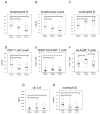Natural killer cell activation distinguishes Mycobacterium tuberculosis-mediated immune reconstitution syndrome from chronic HIV and HIV/MTB coinfection
- PMID: 21826013
- PMCID: PMC3196770
- DOI: 10.1097/QAI.0b013e31822e0d15
Natural killer cell activation distinguishes Mycobacterium tuberculosis-mediated immune reconstitution syndrome from chronic HIV and HIV/MTB coinfection
Abstract
Background: With increased access to antiretroviral treatment (ART), immune reconstitution inflammatory syndrome (IRIS) in Mycobacterium tuberculosis (MTB)-infected populations remains a clinical challenge. We studied a cross-sectional cohort of HIV-infected subjects in Johannesburg (South Africa) to help define the immune correlates that best distinguish IRIS from ongoing MTB cases.
Methods: We studied HIV+ subjects developing MTB-related unmasking tuberculosis-related immune reconstitution inflammatory syndrome (uTB-IRIS) after ART initiation; control groups were subjects with HIV and HIV/tuberculosis-coinfected subjects with comparable ART treatment. Testing was conducted with whole blood-based 4-color flow cytometry and plasma-based Luminex cytokine assessment.
Results: Natural killer cell activation, C-reactive protein, and interleukin 8 serum concentration were significantly higher in uTB-IRIS subjects compared with both control groups. In addition, all MTB-coinfected subjects, independent of clinical presentation, had higher neutrophils and T-cell activation, together with lower lymphocytes, CD4⁺ T-cell, and myeloid dendritic cell counts. Using conditional inference tree analysis, we show that elevated natural killer cell activation in combination with lymphocyte count characterizes the immunological profile of uTB-IRIS.
Conclusion: Our results support a role for innate immune effectors in the immunopathogenesis of unmasking MTB-related IRIS and identify new immune parameters defining this pathology.
Conflict of interest statement
Conradie, F.: no conflict of interest declared
Foulkes A.S.: no conflict of interest declared
Ive, P.: no conflict of interest declared
Yin X.: no conflict of interest declared
Roussos K.: no conflict of interest declared
Glencross D.: no conflict of interest declared
Lawrie D.: no conflict of interest declared
Stevens W.: no conflict of interest declared
Montaner L.J.: no conflict of interest declared
Sanne I.: no conflict of interest declared
Azzoni L.: no conflict of interest declared
Figures



Similar articles
-
Robust Reconstitution of Tuberculosis-Specific Polyfunctional CD4+ T-Cell Responses and Rising Systemic Interleukin 6 in Paradoxical Tuberculosis-Associated Immune Reconstitution Inflammatory Syndrome.Clin Infect Dis. 2016 Mar 15;62(6):795-803. doi: 10.1093/cid/civ978. Epub 2015 Nov 26. Clin Infect Dis. 2016. PMID: 26611774 Free PMC article.
-
Immunological profiling of tuberculosis-associated immune reconstitution inflammatory syndrome and non-immune reconstitution inflammatory syndrome death in HIV-infected adults with pulmonary tuberculosis starting antiretroviral therapy: a prospective observational cohort study.Lancet Infect Dis. 2015 Apr;15(4):429-38. doi: 10.1016/S1473-3099(15)70008-3. Epub 2015 Feb 9. Lancet Infect Dis. 2015. PMID: 25672566 Free PMC article.
-
Dynamics of T-Lymphocyte Activation Related to Paradoxical Tuberculosis-Associated Immune Reconstitution Inflammatory Syndrome in Persons With Advanced HIV.Front Immunol. 2021 Oct 7;12:757843. doi: 10.3389/fimmu.2021.757843. eCollection 2021. Front Immunol. 2021. PMID: 34691079 Free PMC article.
-
The immunopathogenesis of the HIV tuberculosis immune reconstitution inflammatory syndrome.Eur J Immunol. 2013 Aug;43(8):1995-2002. doi: 10.1002/eji.201343632. Eur J Immunol. 2013. PMID: 23928963 Review.
-
[IRIS: a paradoxical inflammatory reaction in patients treated simultaneously for tuberculosis and HIV].Med Sci (Paris). 2015 Jan;31(1):53-9. doi: 10.1051/medsci/20153101013. Epub 2015 Feb 6. Med Sci (Paris). 2015. PMID: 25658731 Review. French.
Cited by
-
Corticosteroid therapy, vitamin D status, and inflammatory cytokine profile in the HIV-tuberculosis immune reconstitution inflammatory syndrome.Clin Infect Dis. 2012 Oct;55(7):1004-11. doi: 10.1093/cid/cis577. Epub 2012 Jun 19. Clin Infect Dis. 2012. PMID: 22715179 Free PMC article.
-
HIV-tuberculosis-associated immune reconstitution inflammatory syndrome is characterized by Toll-like receptor and inflammasome signalling.Nat Commun. 2015 Sep 24;6:8451. doi: 10.1038/ncomms9451. Nat Commun. 2015. PMID: 26399326 Free PMC article.
-
Tuberculosis IRIS: Pathogenesis, Presentation, and Management across the Spectrum of Disease.Life (Basel). 2020 Oct 29;10(11):262. doi: 10.3390/life10110262. Life (Basel). 2020. PMID: 33138069 Free PMC article. Review.
-
HIV-1 and the immune response to TB.Future Virol. 2013 Jan;8(1):57-80. doi: 10.2217/fvl.12.123. Future Virol. 2013. PMID: 23653664 Free PMC article.
-
Cellular immune activation in cerebrospinal fluid from ugandans with cryptococcal meningitis and immune reconstitution inflammatory syndrome.J Infect Dis. 2015 May 15;211(10):1597-606. doi: 10.1093/infdis/jiu664. Epub 2014 Dec 9. J Infect Dis. 2015. PMID: 25492918 Free PMC article.
References
-
- WHO. Global Tuberculosis Control 2009: Epidemiology, strategy, financing. Geneva, CH: World Health Organization; 2009.
-
- Lawn SD, Myer L, Bekker LG, Wood R. Burden of tuberculosis in an antiretroviral treatment programme in sub-Saharan Africa: impact on treatment outcomes and implications for tuberculosis control. AIDS. 2006 Aug 1;20(12):1605–1612. - PubMed
-
- Blanc FX, Sok T, Laureillard D, et al. Significant enhancement in survival with early (2 weeks) vs. late (8 weeks) initiation of highly active antiretroviral treatment (HAART) in severely immunosuppressed HIV-infected adults with newly diagnosed tuberculosis. Paper presented at: International Aids Society Conference; July 22, 2010; Vienna.
Publication types
MeSH terms
Substances
Grants and funding
LinkOut - more resources
Full Text Sources
Other Literature Sources
Medical
Research Materials

